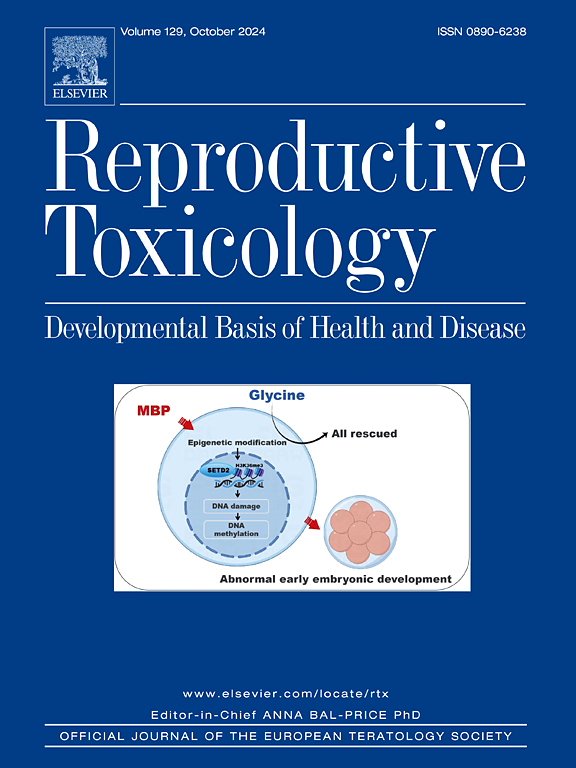The impact of triadimenol on male fertility: An in vitro study and molecular docking examination
IF 3.3
4区 医学
Q2 REPRODUCTIVE BIOLOGY
引用次数: 0
Abstract
Triadimenol, a triazole fungicide, induces various adverse effects including neurotoxicity, hepatotoxicity, and developmental/reproductive toxicity in non-target organisms. Occupational exposure generally occurs in male agricultural workers. Investigating the effects of triadimenol on three different testicular cell lines would be valuable in elucidating the mechanisms underlying male reproductive issues or infertility. This preliminary study examines the potential toxic effects of triadimenol exposure in Leydig (TM3), Sertoli (TM4), and mouse-derived Spermatogonia (GC-1) cell lines, which are representative of the male reproductive system in vitro. The median inhibitory concentration (IC50) values of triadimenol were found to be 121.35 μM, 332.1 μM, and 349.49 μM in TM3, TM4, and GC-1 cells, respectively. The exposure doses were determined to range from 0 to 100 µM in TM3 cell line and 0–300 µM in TM4 and GC-1 cell lines. Reactive oxygen species (ROS) production, reduced glutathione (GSH) content, malondialdehyde (MDA) and protein carbonyl levels, and genotoxicity were examined. TM3 cell line was more resistant to oxidative damage than the other cell lines, while TM4 cell line was found to be more sensitive in terms of protein carbonyl formation. Triadimenol damaged DNA in TM3 cell line (≥16.93), TM4 cell line (≥9.18), and GC-1 cell line (≥3.28). Additionally, the docking score of triadimenol on the active site of steroid 5-α-reductase 2 (5αR2), which converts testosterone to 5α-dihydrotestosterone, was not close. The results emphasised that the toxicity of triadimenol was cell-specific. Overall, triadimenol disrupted male fertility by affecting spermatogenesis, testosterone production, germ cell support, and sperm quality.
三雌醇对男性生育能力的影响:体外研究和分子对接检验
三苯丙啶醇是一种三唑类杀菌剂,可对非靶生物产生多种不良反应,包括神经毒性、肝毒性和发育/生殖毒性。职业接触通常发生在男性农业工人中。研究三美地诺对三种不同睾丸细胞系的影响将有助于阐明男性生殖问题或不孕症的机制。本初步研究探讨了三戊三醇暴露对体外男性生殖系统中具有代表性的Leydig (TM3)、Sertoli (TM4)和小鼠源性精原细胞(GC-1)细胞系的潜在毒性作用。对TM3、TM4和GC-1细胞的IC50中值分别为121.35 μM、332.1 μM和349.49 μM。TM3细胞系的暴露剂量为0 ~ 100 µM, TM4和GC-1细胞系的暴露剂量为0 ~ 300 µM。检测了活性氧(ROS)生成、还原型谷胱甘肽(GSH)含量、丙二醛(MDA)和蛋白羰基水平以及遗传毒性。TM3细胞系对氧化损伤的抵抗能力强于其他细胞系,而TM4细胞系对蛋白质羰基形成更为敏感。三美地诺损伤TM3细胞系(≥16.93)、TM4细胞系(≥9.18)和GC-1细胞系(≥3.28)的DNA。此外,三炔醇在将睾酮转化为5α-二氢睾酮的类固醇5-α-还原酶2活性位点(5α r2)上的对接评分也不接近。结果表明,三苯胺的毒性具有细胞特异性。总的来说,三炔醇通过影响精子发生、睾酮产生、生殖细胞支持和精子质量来破坏男性生育能力。
本文章由计算机程序翻译,如有差异,请以英文原文为准。
求助全文
约1分钟内获得全文
求助全文
来源期刊

Reproductive toxicology
生物-毒理学
CiteScore
6.50
自引率
3.00%
发文量
131
审稿时长
45 days
期刊介绍:
Drawing from a large number of disciplines, Reproductive Toxicology publishes timely, original research on the influence of chemical and physical agents on reproduction. Written by and for obstetricians, pediatricians, embryologists, teratologists, geneticists, toxicologists, andrologists, and others interested in detecting potential reproductive hazards, the journal is a forum for communication among researchers and practitioners. Articles focus on the application of in vitro, animal and clinical research to the practice of clinical medicine.
All aspects of reproduction are within the scope of Reproductive Toxicology, including the formation and maturation of male and female gametes, sexual function, the events surrounding the fusion of gametes and the development of the fertilized ovum, nourishment and transport of the conceptus within the genital tract, implantation, embryogenesis, intrauterine growth, placentation and placental function, parturition, lactation and neonatal survival. Adverse reproductive effects in males will be considered as significant as adverse effects occurring in females. To provide a balanced presentation of approaches, equal emphasis will be given to clinical and animal or in vitro work. Typical end points that will be studied by contributors include infertility, sexual dysfunction, spontaneous abortion, malformations, abnormal histogenesis, stillbirth, intrauterine growth retardation, prematurity, behavioral abnormalities, and perinatal mortality.
 求助内容:
求助内容: 应助结果提醒方式:
应助结果提醒方式:


